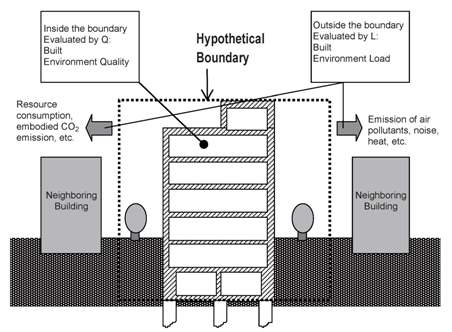 |
| Home | Overview | Background | Assessment Method | Assessment Tool | Download | Statistics | Link |

Two Categories of Assessment: Q and L
Under CASBEE there are two spaces, internal and external, divided by the hypothetical boundary, which is defined by the site boundary and other elements, with two factors related to the two spaces. Thus we have put forward CASBEE in which the "negative aspects of environmental impact which go beyond the hypothetical enclosed space to the outside (the public property)" and "improving living amenity for the building users" are considered side by side. Under CASBEE, these two factors are defined below as Q and L, the main assessment categories, and evaluated separately.
Q
(Quality): Built Environment Quality
Evaluates "improvement in living amenity for the building users,
within the hypothetical enclosed space (the private property)."
L
(Load): Built Environment Load
Evaluates "negative aspects of environmental impact which go beyond
the hypothetical enclosed space to the outside (the public property)."
Figure
5. Division of the assessment categories for Q: Built Environment Quality
and
L: Built Environment Load based on the hypothetical boundary
Four Target Fields of CASBEE and Its Rearrangement
CASBEE
covers the following four assessment fields: (1) Energy efficiency (2)
Resource efficiency (3) Local environment (4) Indoor environment. These
four fields are largely the same as the target fields for the existing
assessment tools described above in Japan and abroad, but they do not
necessarily represent the same concepts, so it is difficult to deal with
them on the same basis. Therefore the assessment categories contained
within these four fields had to be examined and reorganized. As a result,
the assessment categories were classified as shown in Figure 4 into BEE
numerator Q (built environment quality) and BEE denominator L (built environment
load). Q is further divided into three items for assessment: Q1 Indoor
environment, Q2 Quality of services and Q3 Outdoor environment on site.
Similarly, L is divided into L1 Energy, L2 Resources & Materials and L3
Off-site Environment.

Figure
6. Classification and rearrangement of assessment items into
Q (built environment quality) and L (built environment load)
Environmental Labeling Using Built Environment Efficiency (BEE)
As explained above, BEE (Building Environment Efficiency), using Q and L as the two assessment categories, is the core concept of CASBEE. BEE, as used here, is an indicator calculated from Q (built environmental quality ) as the numerator and L (built environment load) as the denominator.

The use of BEE enabled simpler and clearer presentation of building environmental performance assessment results. BEE values are represented on the graph by plotting L on the x axis and Q on the y axis. The BEE value assessment result is expressed as the gradient of the straight line passing through the origin (0,0). The higher the Q value and the lower the L value, the steeper the gradient and the more sustainable the building is. Using this approach, it becomes possible to graphically present the results of built environment assessments using areas bounded by these gradients. The figure shows how the assessment results for buildings can be ranked on a diagram as class C (poor), class B-, class B+, class A, and class S (excellent), in order of increasing BEE value.
Figure 7. Labeling Based on Built Environment Efficiency (BEE)
All Rights Reserved.

